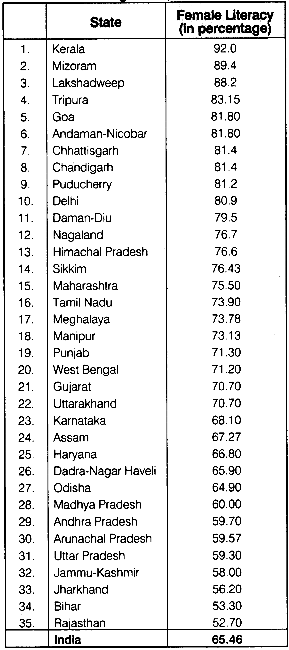Rajasthan Board RBSE Class 12 Geography Chapter 14 India: Composition of Population
RBSE Class 12 Geography Chapter 14 Text Book Questions
RBSE Class 12 Geography Chapter 14 Multiple Choice Questions
Question 1.
Santhal Tribes of India belong to:
(a) Negrito
(b) Primitive Australoid
(c) Mongoloid
(d) Eastern Mediterranean Race
Answer:
(b) Primitive Australoid
Question 2.
The race which was the last to get settled in India:
(a) Negrito
(b) Mongoloid
(c) Nordic
(d) Alpo – Denerik
Answer:
(c) Nordic
Question 3.
Which of the following is the largest linguistic group in India?
(a) Chinese – Tibetan
(b) Austric
(c) Indo – Aryan (Indo – European)
(d) Dravidian
Answer:
(c) Indo – Aryan (Indo – European)
Question 4.
How much of the Indian population lives in rural areas?
(a) 717 million
(b) 833 million
(c) 847 million
(d) 853 million
Answer:
(b) 833 million
Question 5.
The state with the highest sex – ratio as per 2011 census is:
(a) Kerala
(b) Himachal Pradesh
(c) Uttarakhand
(d) Nagaland
Answer:
(a) Kerala
Question 6.
The state with the lowest sex – ratio as per 2011 census is:
(a) Punjab
(b) Himachal Pradesh
(c) Uttarakhand
(d) Haryana
Answer:
(d) Haryana
Question 7.
What is the literacy rate in India according to 2011 census?
(a) 49.5%
(b) 74.04%
(c) 42.5%
(d) 65.38%
Answer:
(b) 74.04%
Question 8.
Which state of India has the highest ratio of the Hindus?
(a) Uttar Pradesh
(b) Madhya Pradesh
(c) Himachal Pradesh
(d) Andhra Pradesh
Answer:
(c) Himachal Pradesh
Question 9.
The birthplace of the Mongol race is:
(a) India
(b) Indonesia
(c) China
(d) Central – Western Asia
Answer:
(c) China
Question 10.
Which state of India has the highest literacy rate?
(a) Goa
(b) Kerala
(c) Tamil Nadu
(d) Karnataka
Answer:
(b) Kerala
Question 11.
The percentage of rural population of India as per 2011 census is:
(a) 50%
(b) 67%
(c) 68.84%
(d) 80%
Answer:
(c) 68.84%
RBSE Class 12 Geography Chapter 14 Very Short Answer Type Questions
Question 12.
Which state of India has the highest sex ratio as per 2011 census?
Answer:
According to 2011 census, in India, Kerala has the highest sex ratio (1084).
Question 13.
What is the national average of urban population in India according to 2011 census?
Answer:
As per 2011 census, the national average of urban population in India is 31.20%.
Question 14.
Which state of India has the lowest literacy rate according to 2011 census?
Answer:
In India, Bihar is the state with the lowest literacy rate (63.82%) in the year 2011.
Question 15.
Which state of India has the highest percentage of rural population according to 2011 census?
Answer:
As per census of 2011, the highest percentage of rural population in India is in Uttar Pradesh (18.6%). While, the highest percentage of rural population in the total population of the state was in Mizoram (48.5%).
RBSE Class 12 Geography Chapter 14 Short Answer Type Questions
Question 16.
What is meant by Population Composition?
Answer:
Population Composition presents social characteristics of the population living in an area. Under this, the study of age, gender, place of residence, human race symptoms, tribes, languages, religion, marital status, literacy, education and occupational features are included.
Question 17.
Define sex – ratio and explain its significance.
Answer:
The sex – ratio is the ratio between the number of women and men in a population group. In this, the number of women per 1,000 men is calculated.
![]()
Sex ratio is considered an important factor in the development of an economy of a countary and society and in increasing its standard of living. Sex ratio expresses the qualitative aspect of population.
Question 18.
What are the reasons responsible for low sex ratio in India?
Answer:
Giving preference to the birth of sons over daughters, child marriage, low level of women in society, lack of education for girls, prime importance to men in society, increasing urbanisation, etc. are main reasons for low sex ratio in India.
Question 19.
What are the main reasons for the increase in literacy in India after independence?
Answer:
Establishment of schools in different areas and increasing public awareness towards education are the main reasons for increase in literacy in India after independence. Besides this, rapid increase in female literacy compared to male literacy has made a significant contribution in enhancing the literacy level in India. Social media and government policies also have encouraged general people towards providing educational facilities to their children.
Question 20.
In which states of India is a large rural population found as per 2011 census?
Answer:
According to 2011 census, a large rural population is found in the following states of India:
I. Himachal Pradesh 89.96%
2. Bihar 88.70%
3. Assam 85.92%
4. Odisha 83.32%
5. Meghalaya 79.92%
6. Uttar Pradesh 77.72%
7. Arunachal Pradesh 77.33%
RBSE Class 12 Geography Chapter 14 Essay Type Questions
Question 21.
Analyze the population composition of India.
Answer:
The combined study of the age, gender, place of residence, human race symptoms, language, religion, literacy, tribe, rural – urban status etc. of the population living in an area is known as the Population Composition. On this basis, the composition of population of India has been analyzed under the following titles:
- Rural – urban population.
- Sex ratio.
- Age structure.
- Literacy.
- Language Composition.
- Religious Structure.
- Racial Struture.
1. Rural – urban Population:
In the year 2011, total population of India was 121.02 crore, in which 83.31 crore population (68.8% of the total population) was rural, while 37.71 crore population (31.20% of the total population) was urban. In India, the highest concentration of rural population (percentage of rural population in the total population of the state) is found in the states – Himachal Pradesh (89.96%), Bihar (88.70%), Assam (85.92%), Odisha (83.32%), Meghalaya (79.92%), Uttar Pradesh (77.72%) and Arunachal Pradesh (77.33%). In India, the highest concentration of urban population (percentage of urban population in the total population of the state) is found in the states – Tamil Nadu (48.45%), Kerala (47.72%), Maharashtra (45.23%), Gujarat (42.58%), Karnataka (38.57%) and Punjab (37.49%)
2. Sex – Ratio:
In the year 2011, the average sex-ratio in India was 940. In 2011, the states having a higher sex-ratio than the average sex – ratio of India were Kerala (1084), Tamil Nadu (995), Andhra Pradesh (992), and the union territories like Puducherry (1031) and Lakshadweep (945), whereas, the states having the lowest sex ratio were Haryana (877), Jammu – Kashmir (883), Sikkim (889), and the union territories like Daman and Diu (618), Dadra and Nagar Haveli (775) and Chandigarh (818).
3. Age Structure:
The study of the percentage of the population of people of different age – groups of a country comes under the category of age structure. As per 2011 census, 29.5% of the total population of India consists of juvenile group (0 – 14 age group), 62.5% consists of adult group (15 – 59 years) and 8% consists of old – age group (60 years and above).
4. Literacy:
In 2011, the literacy rate in the country was 74.04%. The states/union territories with higher literacy than the average include Kerala (93.91%), Lakshadweep (92.2%) and Mizoram (91.58%) whereas, the states with lowest literacy rate include Bihar (63.82%), Rajasthan (67.06%), Jammu – Kashmir (68.74%), Uttar Pradesh (69.72%) and Madhya Pradesh (70.63%).
5. Language Composition:
According to the 2011 census, Hindi is the mother-tongue of 48.69 crore people in the country (40.22% of the total population). The other major languages of the country include Bengali (8.3% of the total population), Telugu (7.87%), Marathi (7.45%), Tamil (6.32%), Urdu (5.18%) and Gujarati (4.85%). The other languages spoken in the country include Kannada (3.91%), Malayalam (3.62%), Oriya (3.35%), Punjabi (2.79%) and Assamese (1.56%).
6. Religious Structure:
In 2011, the followers of the Hindu religion constitute 79.56% of the total population of India. Whereas, the percentage of the followers of the Muslim, Christian, Sikh, Buddhist and Jain religion is respectively 14.31, 2.36, 1.74, 0.77 and 0.41 percent of the total population of the country. In India, the highest percentage of the Hindu population at the state level is in Himachal Pradesh (95.43%) and the lowest percentage is in Mizoram (3.55%). The highest percentage of the Muslim population is found in Lakshadweep (94.92%) and the lowest percentage is in Mizoram (1.14%). In terms of population-size, the states with highest Muslim population include Uttar Pradesh, West Bengal and Bihar.
7. Racial structure:
The Races found in India include Negrito, Proto – Australoid, Mongoloid, Mediterranean, Broad. Headed Western Races and Nordic Races. Negrito race is found primarily in the states like Nagaland and Jharkhand. Proto – Australoid race is found mainly in Central India and in the mountainous forest areas of South India. Mongoloid tribe resides in north – eastern states, Sikkim, Lahaul – Spiti and in areas of Ladakh. Nordic Race lives in north – western – parts of India. Mediterranean and broad – headed western Race are found residing in different regions of India.
Question 22.
Analyze the changing nature of rural and urban population in India. Explain the reasons for increase in urban population.
Answer:
The changing nature of rural and urban population in India:
There has been a continuous change in the nature of rural and urban population in India between 1921 and 2011, which is being presented in the given table:
Rural and Urban Population (1921 to 2011):
| Year | Rural Population (in crore) | Urban Population (in crore) | Percentage of Urban Population in Total Population |
| 1921 | 22.32 | 2.81 | 11.20 |
| 1931 | 24.55 | 3.35 | 12.00 |
| 1941 | 27.45 | 4.42 | 13.80 |
| 1951 | 29.86 | 6.24 | 17.30 |
| 1961 | 36.03 | 7.89 | 18.00 |
| 1971 | 43.90 | 10.91 | 19.90 |
| 1981 | 53.89 | 15.95 | 23.40 |
| 1991 | 62.72 | 21.72 | 25.70 |
| 2001 | 74.17 | 28.54 | 27.80 |
| 2011 | 83.31 | 37.71 | 31.20 |
Source:
Census of India, 2011. It is clear from the above table that in 1921, about 88.8% of the total population of India lived in villages, which reduced to 82.70% by 1951, 80.1% by 1971, 74.3% by 1991 and further reduced to 68.80% by 2011. It is clear that since 1971, there has been a continuous decline in the percentage of rural population in total population of India. On the other hand in 1921, the percentage of urban population in total population of India was 11.2, which increased to 17.3% by 1951, 19.9% by 1971, 25.70% by 1991, and rapidly increased to 31.2% by 2011. This increasing percentage of urban population is the indicator of increased urbanisation.
The Reasons for the Increase in Urban Population in India:
In 1911, the percentage of urban population in total population of India was only 10%, which rapidly increased to 31.2% by 2011. In India, the following reasons have been contributing to the increasing trend of urbanisation:
- Lack of employment opportunities in rural areas.
- Declining profitability in Agriculture.
- More amenities in urban areas as compared to rural areas.
- Attractions of cities.
- Better facility of education in urban areas.
- Industrialisation.
- Development of modes of transport and communication in cities.
- Closure of small scale and cottage industries in rural areas.
Question 23.
Explain in detail the nature of literacy in India.
Answer:
Literacy is considered to be the criteria for the development of any civilised society. Literacy is an indicator of the economy of a country, urbanisation, standard of living, caste composition, condition of women in society, educational facilities, development of modes of transport and technological development, etc.
Nature of literacy in India:
In 2011, the literacy rate in India was 74.04%. Since 1961, there has been a rapid increase in the average literacy rate of India. But literacy rate of India has increased unevenly at the regional level. At present (in 2011), on the basis of variations found in literacy rates, the states of India can be categorized into the following groups:
1. States / union territories With literacy rate of more than 80%:
In 2011, the states/ union territories with literacy rate of more than 80% were as follows:
Kerala (93.91%), Lakshadweep (92.28%), Mizoram ( 91.58%), Tripura (87.75%), Goa (87.40%), Daman and Diu (87.07%), Puducherry (86.55%), Chandigarh (86.43%), Chhattisgarh (86.40%), Delhi (86.34%), Andaman – Nicobar (86.27%), Himachal Pradesh (83.78%), Maharashtra (82.91%), Sikkim (82.28%), Tamil Nadu (80.33%) and Nagaland (80.11%).
2. States / union territories with literacy rate between 70% and 80%:
In 2011, this group includes the following 10 states and one union territory in India:
Manipur (79.85%), Uttarakhand (79.63%), Gujarat (79.31%), Dadra-Nagar Haveli (77.65%), West Bengal (77.08%), Punjab (76.68%), Haryana (76.64%), Karnataka (75.60%), Meghalaya (75.48%), Odisha (73.45%), Assam (73.18%) and Madhya Pradesh (70.63%).
3. States with literacy rate less than 70%:
In 2011, the states with literacy rate of 65% to 70% include Uttar Pradesh (69.72%), Jammu – Kashmir (68.74%), Andhra Pradesh (67.70%), Jharkhand (67.63%), Rajasthan (67.06%), Arunachal Pradesh (670 %), and Bihar (63.82%).
The literacy rates found in India are being presented in the following map:
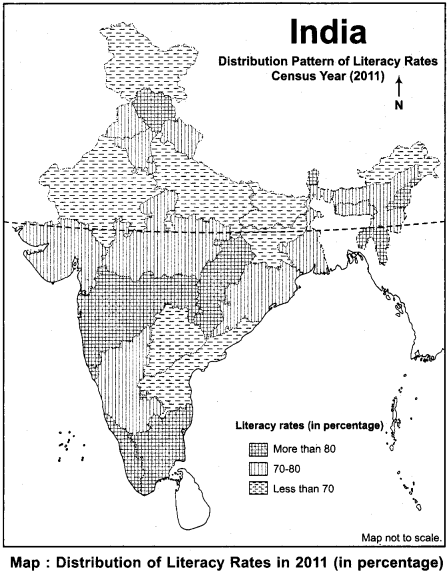
Numerical Based Questions
Question 24.
Display the literacy percentage of 2011 In the map of India.
Answer:
In the map of India, the literacy percentage (2011) is as follows:
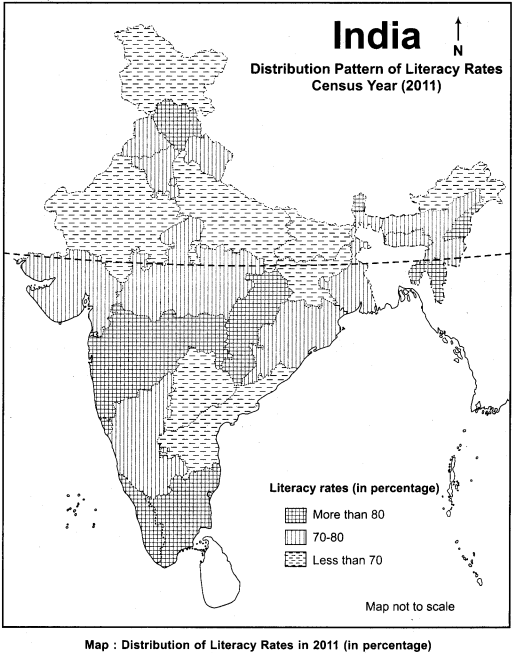
Question 25.
Display the literacy rate in India from 1901 to 2011 through a linear graph.
Answer:
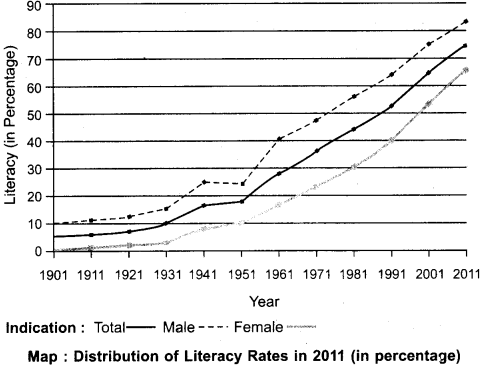
RBSE Class 12 Geography Chapter 14 Additional Questions with Answers
RBSE Class 12 Geography Chapter 14 Multiple Choice Questions
Question 1.
Which of the following states of India had the maximum number of villages in 2011?
(a) Madhya Pradesh
(b) Rajasthan
(c) Uttar Pradesh
(d) Odisha
Answer:
(c) Uttar Pradesh
Question 2.
The percentage of urban population in total population of India in 2011 was:
(a) 23.4
(b) 28.3
(c) 30.2
(d) 31.2
Answer:
(d) 31.2
Question 3.
Which of the following states of India had the highest number of cities in 2011?
(a) Tamil Nadu
(b) Uttar Pradesh
(c) Madhya Pradesh
(d) Karnataka
Answer:
(a) Tamil Nadu
Question 4.
Which of the following states of India had the highest percentage of increase in urban population in the decade 2001 – 11?
(a) Tamil Nadu
(b) Mizoram
(c) Kerala
(d) Maharashtra
Answer:
(b) Mizoram
Question 5.
Which of the following union territories had the highest sex ratio in 2011?
(a) Puducherry
(b) Lakshadweep
(c) Dadra – Nagar Haveli
(d) Daman – Diu
Answer:
(a) Puducherry
Question 6.
The percentage of the population of child-age group in total population of India in 2011 was:
(a) 25.6
(b) 28.6
(c) 29.5
(d) 32.2
Answer:
(c) 29.5
Question 7.
The percentage of the population of age group 15 – 59 in total population of India in 2011 was:
(a) 58.1
(b) 62.5
(c) 63.8
(d) 65.2
Answer:
(b) 62.5
Question 8.
Which of the following states has the highest population of child-age group in 2011?
(a) Uttar Pradesh
(b) Maharashtra
(c) Bihar
(d) Rajasthan
Answer:
(a) Uttar Pradesh
Question 9.
Munda and Kol tribes are related to which of the following ethnic groups?
(a) Proto – Australoid
(b) Negrito
(c) Nordic
(d) Mongoloid
Answer:
(a) Proto – Australoid
Match the Following
Question 1.
Match the options given in column A with right options given in column B.
| Column A (Tribe) | Column B (Race) |
| (i) Badgish | (a) Proto – Australoid |
| (ii) Kol | (b) Mongoloid |
| (iii) Gaddi | (c) Nordic |
| (iv) Denarik | (d) Negrito |
Answer:
(i) d, (ii) a, (iii) b, (iv) c.
RBSE Class 12 Geography Chapter 14 Very Short Answer Type Questions
Question 1.
Name the leading states of India in terms of number of villages in 2011.
Answer:
In 2011, in terms of number of villages, the leading states are Uttar Pradesh, Madhya Pradesh, Odisha, Bihar and Rajasthan.
Question 2.
Name the leading states of India in terms of number of cities.
Answer:
In India, in terms of number of cities, the leading states are Tamil Nadu (721), Uttar Pradesh (648), Madhya Pradesh (364), Maharashtra (256), Karnataka (220), Gujarat (195) and Rajasthan (185).
Question 3.
Which states of India have high urban population percentage?
Answer:
In India, the states with high urban population percentage are Tamil Nadu (48.45%), Kerala (47.72%), Maharashtra (45.23%), Gujarat (42.58%), Karnataka (38.57%) and Punjab (37.49%).
Question 4.
Which factors are responsible for increase in urban population in India?
Answer:
Lack of employment opportunities in rural areas, more amenities in urban areas as compared to rural areas, attraction of cities, better education system in cities, industrialisation, development of modes of transport and communication in cities, low agriculture profitability in rural areas, closure of small scale and cottage industries in rural areas are the factors primarily responsible for increase in urban population in India.
Question 5.
Which facilities are adversely affected by increasing urbanisation in India?
Answer:
Urban environment, sex ratio and urban community facilities are adversely affected by the increasing urbanisation in India.
Question 6.
What is the average sex ratio of India and the world?
Answer:
The average sex ratio of India is 940, while the average sex ratio of the world is 948.
Question 7.
Mention main factors responsible for decreasing sex ratio in India.
Answer:
Preference to the birth of sons, child marriage, lower level of women in society and prime importance to men in society are main factors responsible for decreasing sex ratio in India.
Question 8.
Name the states with higher sex ratio than the national average.
Answer:
The states with a higher sex ratio than the national average include Kerala (1084), Tamil Nadu (995), Andhra Pradesh (992), Chhattisgarh (991), Manipur (987), Meghalaya (986), Odisha (978), Himachal Pradesh (974), Karnataka (968), Tripura (961) and in Puducherry (1035) and Lakshadweep (946) union territories.
Question 9.
Name the states/union territories with lower sex ratio than the national average.
Answer:
The states with a lower sex ratio than the national average include Haryana (877), Bihar (916), Jammu – Kashmir (883), Sikkim (889), Punjab (893), Uttar Pradesh (908). Gujarat (918), Rajasthan (926), Arunachal Pradesh (920), Nagaland (931), Madhya Pradesh (930) and Maharashtra (925). While, the union – territories in this context include Daman and Diu (618), Dadra – Nagar Haveli (775) and Chandigarh (818).
Question 10.
In which states/union territories did the sex ratio decrease in the decade 2001 – 2011?
Answer:
During the decade 2001 – 2011, the sex ratio decreased in the states of Bihar, Jammu – Kashmir and Gujarat ; and in the union – territories of Daman – Diu, Dadra – Nagar Haveli and Lakshadweep.
Question 11.
What is Age Structure?
Answer:
The ratio of the population of the people of different age groups is called Age Structure.
Question 12.
Into which categories is the population divided in terms of age group?
Answer:
The population is divided into three categories in terms of age group – Juvenile group (0 – 14 age group), Adult group (15 – 59 years) and Old-age group (60 years and above).
Question 13.
In which stage of demographic transition is India?
Answer:
India is in the third stage of demographic transition.
Question 14.
What does the shape of age pyramid of India indicate?
Answer:
The age pyramid of India has a wide base and a sharp peak, which indicates the mobility of the population.
Question 15.
What can be understood by the age structure of India?
Answer:
According to 2011 census, the percentage of child – aged group and old – aged group in India are 29.5 and 8.0 respectively. While, the percentage of Adult group is 62.5, which indicates high dependency ratio. Also, it indicates a high working population in the region.
Question 16.
Which are leading states in terms of the percentage of child – age population in total population?
Answer:
In terms of the percentage of child – age population in total population, leading states are Meghalaya (18.75%), Bihar (17.90%), Jammu – Kashmir (16.01%), Jharkhand (15.89%), Rajasthan (15.31%), Mizoram (15.17%) and Uttar Pradesh (14.90%).
Question 17.
Name the three states having the lowest percentage of child – aged group in 2011.
Answer:
- Tamil Nadu (9.56%).
- Goa (9.57%).
- Kerala (9.95%).
Question 18.
What is the importance of Age Structure?
Answer:
The information about the status of dependent population, labour force and employment status of any country or territory can be identified by Age Structure.
Question 19.
What does Literacy mean?
Answer:
In India, out of the population of more than 7 years of age, such percentage of population that can read and write and has the ability to perform simple arithmetical calculations, is called Literacy.
Question 20.
How many languages are notified in Indian Constitution?
Answer:
22 languages are notified in Indian Constitution.
Question 21.
How many languages and dialects are there in India as per 1961 Indian census?
Answer:
There are 1018 languages and dialects in India as per 1961 Indian census.
Question 22.
What are the factors affecting literacy?
The factors affecting literacy include spread of economy, level of urbanization, standard of living, racial structure, condition of women in society, price mechanism, availability of educational facilities, development of modes of transport and communication, level of technology and public policies.
Question 23.
Hindi is the mother tongue of how much percentage of people in total population of India in 2011?
Answer:
Hindi is the mother tongue of 40.22% people in India.
Question 24.
India is the birth place of which religions of the world?
Answer:
India is the birth place of four religions of the world – Hinduism, Buddhism, Jainism and Sikhism.
Question 25.
What was the ratio of Hindu-Muslim population in India after the partition of India-Pakistan?
answer:
After the partition of India – Pakistan, the percentage of the Hindu population and the Muslim population was respectively 84.1 and 9.8 of the total population in India.
Question 26.
In which state of India is the highest Muslim population found?
Answer:
In Uttar Pradesh.
Question 27.
Into how many groups have Indian languages been divided on the basis of their dialect and origin?
Indian languages have been divided into four groups on the basis of their dialect and origin – Indo – European, Dravidian, Sino Tibetan and AustroAsiatic.
Question 28.
Which race predominantly inhabits the north-eastern states of India (except Assam)?
Answer:
Mongoloid.
Question 29.
Which races are found in India?
Answer:
The races that are found in India are Negrito, Proto – Australoid, Mongoloid, Mediterranean, Nordic and Broad – Headed Western Race.
RBSE Class 12 Geography Chapter 14 Short Answer Type Questions (SA-I)
Question 1.
Name the leading states in terms of number of villages in India and concentration of rural population.
Answer:
Leading states in terms of number of villages – In 2011, number of total villages in the country was 6,40,867. Following are the leading states in terms of number of villages in India – Uttar Pradesh (1,06,704), Madhya Pradesh (54,903), Odisha (51,313), Bihar (44,874), Rajasthan (44,672), Maharashtra (43,663) and West Bengal (40,203).
States having high percentage of rural population in total population of the state – Himachal Pradesh (89.96), Bihar (88.70), Assam (85.92), Odisha (83.32), Meghalaya (79.92), Uttar Pradesh (77.72), Arunachal Pradesh (77.33) etc.
Question 2.
Analyze the decadal growth of urban population in India with the help of a graph.
Answer:
In 1911, the urban population was only 10% of the total population in India, which increased to 11.2% in 1921, 12% in 1931, 13.8% in 1941, 17.3% in 1951, 18% in 1961, 19.9% in 1971, 23.4% in 1981, 25.7% in 1991, 27.8%’in 2001 and it further increased to 31.2% in 2011. This growth of urban population can be well displayed through the further graph:
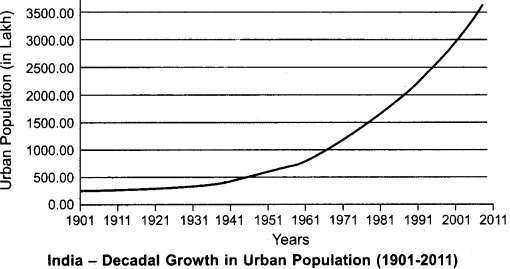
Question 3.
Analyze the changing nature of sex ratio in India.
Answer:
In 1901, the number of women per thousand men was 972 in India, which reduced to 964 in 1911, 955 in 1921, 950 in 1931 and it further reduced to 945 in 1941. In 1951, sex ratio in India increased by one point to 946. After this, it reduced to 941 in 1961, reduced to 930 in 1971 but increased to 934 in 1981. There was a continuous decline in sex ratio till 1991 and it reduced to 927 in 1991. After this, sex ratio of India increased to 933 in 2001 and further increased to 940 in 2011. Many factors have been responsible for this changed nature of sex ratio of India.
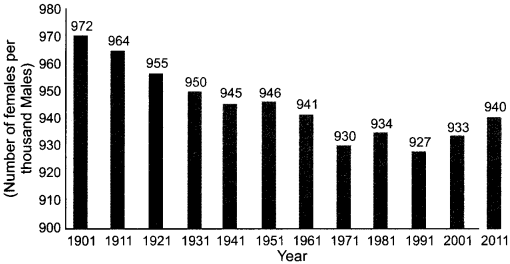
Question 4.
What Is meant by Age Structure? Divide the population of India in terms of age group.
Answer:
The ratio of the population of people of different age groups is called Age Structure. In terms of age-group, there are the following 3 age groups in the census of India:
1. Child – age group (0 – 14 years age – group):
In 2011, the child – age group was 29.5% of total population in India. This age – group is a dependent age – group.
2. Adult – age group (15 – 59 years age – group):
In 2011, the adult-age group was 62.5% of total population in India. This age group is the working age group. More the population will be in this age group, the more the nation will be oriented towards progress.
3. Old – age group (age group of 60 years and above):
In 2011, the old – age group was 8% of total population in India. This age group is also a dependent age group. More of this type of population hinders development of the nation.
Question 5.
Discuss the growth of literacy in India after 1961.
Answer:
Since 1961, there has been a rapid growth in literacy rate of India. In 1961, literacy rate was 28.3% in India, which increased to 34.45% in 1971, 43.57% in 1981, 52.21% in 1991, 64.83% in 2001 and it further increased to 74.04% in 2011. Thus, it is clear that within the last 50 years, literacy rates of India have increased almost three times. The development of schools in different regions, government policies on literacy, awareness in general population towards education are main factors responsible for this growth in literacy rates in India.
Question 6.
Mention the symptoms of Negrito race in the context of India.
Answer:
The symptoms of Negrito race are as follows:
- They are known as India’s first indigenous tribals.
- The height of the people of this race is very short.
- The head of the people of this race is small but their forehead is erected.
- They are black in complexion.
- They have beautiful and wool – like hair.
- The texture of their head is round and moderate.
- Their face is small and nose is flat and broad.
- Angami Naga and Badgish tribes found in India belong to this race.
RBSE Class 12 Geography Chapter 14 Short Answer Type Questions (SA-II)
Question 1.
In which groups have the Indian states been classified in terms of literacy?
Answer:
On the basis of the average literacy rate in India (74.04%), Indian states have been classified into two groups:
1. States with higher literacy rate than the national average:
In this category, Kerala holds the first place with a literacy rate of 93.91%. Lakshadweep holds the second place (92.2%) and Mizoram holds the third place (91.58%). In the male literacy rate, Lakshadweep holds the first place (96.11%) and Kerala holds the second place (96.10%). The highest female literacy rate has been recorded in Kerala (92%).
2. States with lower literacy rate than the national average:
The literacy rate in Bihar is 63.82% which is the lowest in the states. The other states with lower literacy than the national average include Jammu-Kashmir (68.74%), Rajasthan (67.06%), Madhya Pradesh (70.63%), Uttar Pradesh (69.72%), Jharkhand (67.63%), Odisha (73.45%), Arunachal Pradesh (67%) and Assam (73.18%). The lowest male literacy rate has also been recorded in Bihar (73.5%) and in Arunachal Pradesh (73.69%). While, the lowest female literacy rate has been recorded in Rajasthan (52.70%) and in Bihar (53.30%).
Question 2.
Mention the symptoms of Proto – Australoid race.
Answer:
The symptoms of Proto – Australoid race are as follows:
- This race is considered to be inhabited in the central regions of India.
- The presence of this race is found in the mountainous forests of Central and Southern India.
- Their hair is curly and lips twisted.
- The height of these people is short and the body complexion is dark brown.
- This race has played an important role in the development of the Indian culture.
- Malayalis, Mundas, Santhals and Kols are the descendants of this race in India.
RBSE Class 12 Geography Chapter 14 Essay Type Questions
Question 1.
Discuss the regional pattern of urbanisation in India.
Answer:
In 2011, the urban population percent was 31.2% of the total population in India. There are substantial variations in this percentage of urban population in the states/union territories, on the basis of which, India can be divided into 5 categories:
1. States/union territories with more than 50% urban population:
In 2011, the states included, in this category are Goa (62.2%) and Mizoram (52.1%) and the union territories are Delhi (97.5%), Chandigarh (97.3%), Lakshadweep (78.1%), Daman and Diu (75.2%), and Puducherry (68.3%).
2. States/union territories with 40% to 50% urban population:
In 201 1, the states included in this category are Tamil Nadu (48.4%), Kerala (47.7%), Maharashtra (45.2%) and Gujarat (42.6%) and the union territory is Dadra – Nagar Haveli (46.7%).
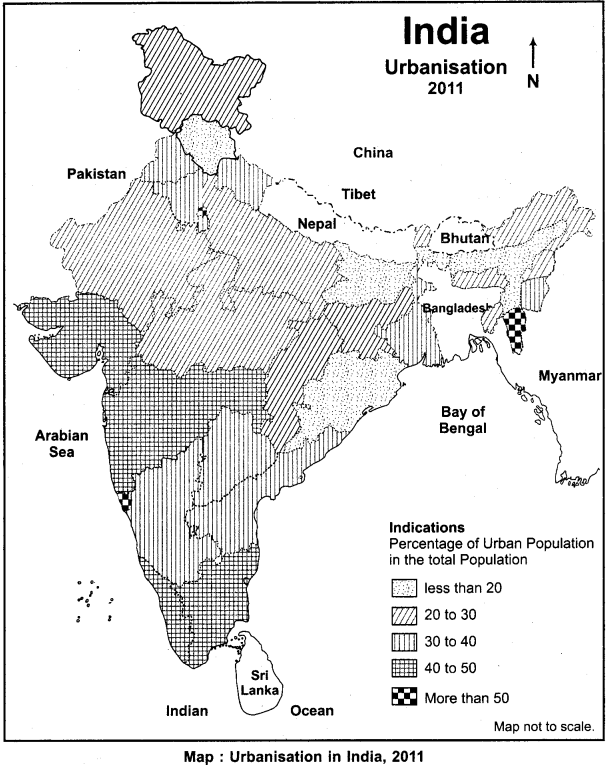
3. States/union territories with 30% to 40% urban population:
In 2011, the states included in this category are Karnataka (38.7%), Punjab (37.5%), Haryana (34.9%), Andhra Pradesh (33.4%), Manipur (32.5%), West Bengal (31.9%) and Uttarakhand (30.2%), and the union territory included is Andaman – Nicobar Islands group.
4. States with 20% to 30% urban population:
In 2011, the states included in this category are Nagaland (28.9%), Madhya Pradesh (27.6%), Jammu – Kashmir (27.4%), Tripura (26.2%), Sikkim (25.2%), Rajasthan (24.9%), Jharkhand (24%), Chhattisgarh (23.2%), Arunachal Pradesh (22.9%), Uttar Pradesh (22.3%) and Meghalaya (20.1%).
5. States with less than 20% urban population:
In 2011, the states included in this category are Odisha (16.7%), Assam (14.1%), Bihar (11.3%) and Himachal Pradesh (10%).
Question 2.
Elucidate the form of state – level distribution of sex ratio in India.
Answer:
According to census of 2011, national average sex ratio of India remained at 940. Significant dissimilarities are noticed in sex ratio of India at state level and on this basis the states of India can be divided into the following two categories:
1. States/Union Territories having higher sex ratio than national average:
In the year 2011, following were the states/union territories with sex ratio more than national average (940).
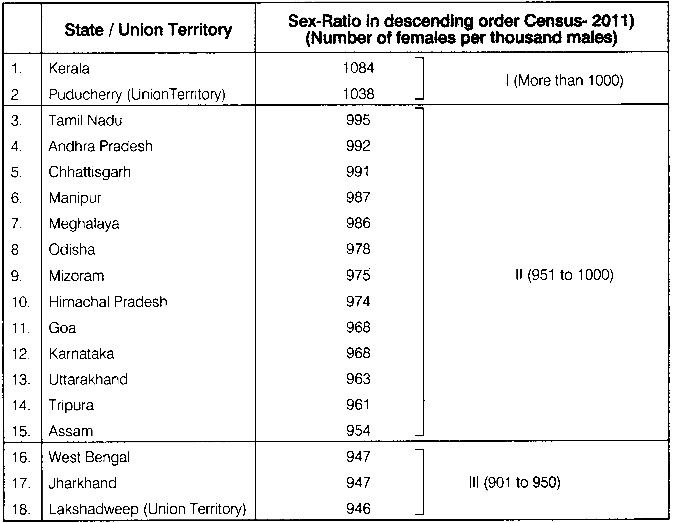
2. States/Union Territories with sex ratio less than national average:
Following were the states/union territories with sex ratio less than national average in the year 2011 in descending order:
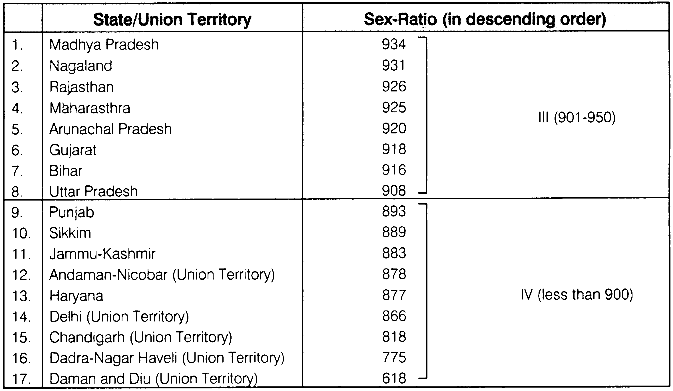
This form of sex ratio found in India has been depicted with the help of the following map:
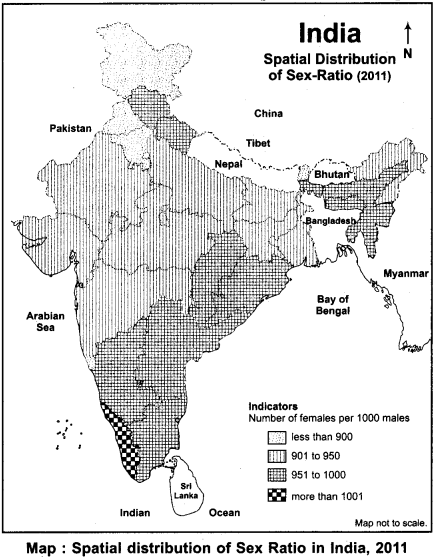
Question 3.
Analyze the major causes of low sex ratio in India.
Answer:
Sex ratio is less in India as compared to developed nations of the world. Major factors responsible for this are as follows:
1. Priority to the birth of son:
Due to the influence of many social, economic and religious reasons in India, priority is given to the birth of son as compared to daughter. Still today, there is no shortage of such couples in India, who verify the gender of child before birth due to the desire for a son and do, not hesitate in commiting female foeticide. Due to this reason, more male babies are born than female babies in the country and sex ratio remains less.
2. Death of young girls during delivery period due to child marriage:
Even today, child marriage is practiced in the economically backward societies of India. Due to child marriage, many girls at an early age have to bear the burden of motherhood, in which many of these young girls die untimely during childbirth. In this case, the sex ratio decreases due to the decrease in the number of females in the society.
3. Economic dependence of women:
In most parts of India, women are financially dependent on men. Generally, most women lead their lives in poverty. They also have to live in the absence of adequate health and medical facilities, also bearing family worries, due to which they die earlier. As a result, the number of women is decreasing in the society.
4. Lack of female education:
Lack of girls education is prevalent in India, due to which, they cannot become financially independent. Being economically weak, most of the girls and women cannot protest against mental, physical and social injustice or atrocities and exploitation done to them.
5. Increasing urbanisation:
On one hand, the urban population is growing steadily in India. While on the other hand, the percentage of urban population in total population of India is declining steadily. This trend reduces the sex ratio in both rural and urban areas.
Question 4.
Discuss major linguistic sections of India.
Answer:
India is a country of linguistic diversity. According to a scholar named Grierson, as per the survey conducted in India from 1903 to 1928, about 197 languages and 544 dialects are spoken in the country. In 1961, according to the Census Department of India, there are 1018 different languages and dialects in the country, while, 22 languages are scheduled in the Indian Constitution. On the basis of their dialects and origin, the languages of India can be divided into the following 4 language families:
1. Indo – European Language Family:
The languages of this family are spoken by about 73% population of the country. Hindi is the main language of this family, which is spoken prominently by about 40% of population of the country in the states of North India. The other languages of this family are Kashmiri, Urdu, Sindhi, Punjabi, Marathi, Konkani, Gujarati, Bengali, Assamese, Chhattisgarhi, Nepali and Pahari. The country’s 8.3% population speaks Bengali, 7.5% population speaks Marathi, 5.2% population speaks Urdu, 4.9% population speaks Gujarati, 3.3% population speaks Oriya, 2.8% population speaks Punjabi and 1.6% population speaks Assamese language.
2. Dravidian Language Family:
The main Indian languages of this language family are Telugu, Tamil, Malayalam and Kannada, which are spoken prominently in Peninsular India. Telugu language is spoken by the country’s 7.9% population, Tamil by the country’s 6.3% population, Kannada by the country’s 3.9% population and Malayalam language is spoken by the country’s 3.6% population. Thus, about 20% population of the country speaks Dravidian languages. Dravidian languages have a dominating presence in different states, like – Telegu in Andhra Pradesh, Tamil in Tamil Nadu, Kannada in Karnataka and Malayalam language in Kerala are the most popular.
3. Sino – Tibetan Language Family:
In India, this is a small language family, in which the languages which are prominently included are Ladakhi in Jammu – Kashmir, Kinnauri and Lepcha in Himachal Pradesh, Dapla, Abor, Bodo, Naga, Myanmari, Kukichin languages in north – eastern states of India.
4. Austro – Asiatic Language Family:
In India, this is also a small language family, in which Santhali, Mandari and Ho languages are spoken in Jharkhand and Western Satpura region, Khasi language is spoken in Meghalaya and Nicobari language is spoken in Nicobar Island.
Question 5.
Discuss the changing nature of religious structure of India.
Answer:
India is a country with religious diversity and it is the birth place of four religions of the world – Hinduism, Buddhism, Jainism and Sikhism.
The changing nature of religious structure of India:
Since the partition of India-Pakistan, change at large level has been experienced in the religious structure of India. Before partition, there were 66.5% Hindus and 23.7% Muslims in the total population of undivided India. In 1947, due to India – Pakistan partition, massive migration of Hindus and Muslims took place. After the partition, in the 1951 census of India, Hindu population was 84.1% and Muslim population was 9.8% in the total population of India. After this, in every census conducted in India, the percentage of Hindu population is steadily decreasing while the percentage of Muslim population is increasing. The table given below clarifies the fact:
| Community | 1961 | 1971 | 1981 | 1991 | 2001 | 2011 |
| Hindu | 83.50 | 82.70 | 82.60 | 82.41 | 80.45 | 79.56 |
| Muslim | 10.7 | 11.2 | 11.4 | 11.67 | 13.43 | 14.31 |
| Christian | 2.4 | 2.6 | 2.4 | 2.32 | 2.34 | 2.36 |
| Sikh | 1.8 | 1.9 | 2.0 | 1.99 | 1.87 | 1.74 |
| Buddhist | 0.7 | 0.7 | 0.7 | 0.77 | 0.77 | 0.77 |
| Jain | 0.5 | 0.5 | 0.5 | 0.41 | 0.41 | 0.41 |
| Other | 0.4 | 0.4 | 0.4 | 0.43 | 0.73 | 0.85 |
It is clear from the above table that in 1961, the Hindu population was 83.5% in the total population of India, which reduced to 82.60% by 1981, and further reduced to 79.56% by 2011. On the other hand, in 1961, the Muslim population was 10.7% in the total population of India, which increased to 11.67% by 1981, and further increased to 14.31% by 2011. Christian, Sikh, Buddhist and Jain are the other minority religious communities residing in India, whose contribution in the total population of India remained almost unchanged.
Question 6.
Present the racial classification of population of India according to B.S. Guha.
Answer:
In 1944, B.S. Guha, being the Director of Archaeological Survey Department of India, classified Indian races into the following 6 categories:
1. Negrito:
The people of this race are found in scattered form in India. Physical symptoms of Negrito race are primarily found in Angami Naga of North – East India and Bardish tribe of Jharkhand. The people of this race are short in height. Their head is small but the forehead is bulged. The shape of their head is round, face small and nose flat and broad. Their lips are thick and twisted. Their head-hair is like wool. They are black in complexion.
2. Proto – Australoid:
At present, the people of this race are found residing in mountainous forest regions of the Central and Southern India. Malayali, Munda, Santhal, Kol and Bhil tribes are considered to be the descendants of this race. Guha believes that it is the native race of India. The people of this race are short in height, skin colour is dark brown, and they have curly hair and twisted lips.
3. Mongoloid:
It is believed that this race came from China and Mongolia and settled in northern and north – eastern regions of India. At present, the people of this race are found residing primarily in Ladakh, Lahaul – Spiti regions, Sikkim, Arunachal Pradesh, Nagaland, Manipur and Mizoram. The people of this race have flat mouth, bulged cheek bones and almond – shaped eyes. Two subdivisions of this race are Eastern Mongoloid and Tibetan Mongoloid.
4. Mediterranean:
Western scholars believe that this race has come in India from Eastern Mediterranean region and south – western Asian region. At present, this race is found residing in Kerala, Tamil Nadu, Odisha and Chota Nagpur Plateau regions of India. This race has contributed significantly in Indian culture.
5. Broad Headed Western Race:
The following 3 groups of this race are found in India – The first group is Elpinoid which at present is found primarily in Gujarat. The second group is Denarik which at present is found in West Bengal, Kathiawar, Kannada and Tamil regions. The third group is Arminoid which at present is found in Maharashtra as Parsee people.
6. Nordic:
This is the race that arrived last in India and settled in the north-western regions of the country in the second century of Christ.
Important Data Related to Population in India, Year 2011:
Table 1:
Major States of India withHighest Rural Population(in descending order) Year 2011:
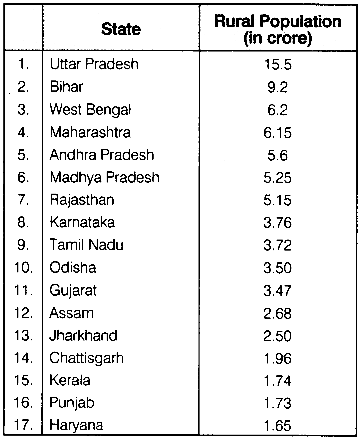
Table 2:
Major States of India with Highest Urban Population (in descending order) Year 2011:
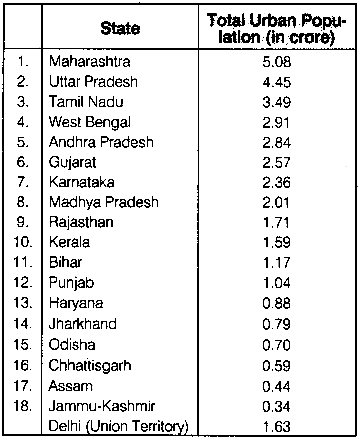
Table 3:
Sex – Ratio in India (1901 – 2011):
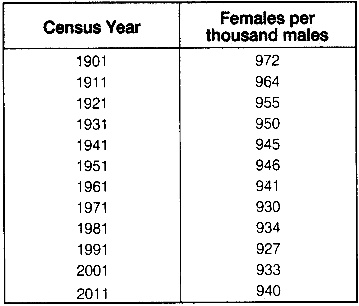
Table 4:
Age – Structure of Indian Population (Percentage of population):
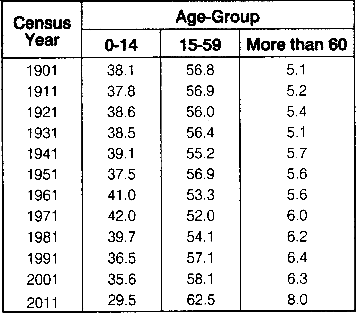
Table 5:
Literacy in India (in percentage):
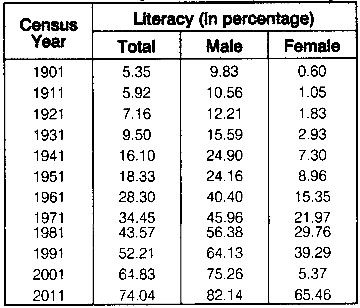
Table 6:
Female Literacy (in percentage) at State/Union Territory Level in India, in descending order, Year 2011:
